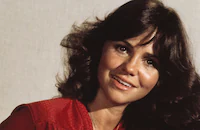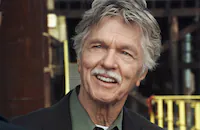Steel Magnolias

Brief Synopsis
Cast & Crew
Herbert Ross
Sally Field
Shirley Maclaine
Julia Roberts
Dolly Parton
Dylan Mcdermott
Film Details
Technical Specs
Synopsis
Based on a true incident of screenwriter Harling's mother and sister, the story is set in a small-town beauty shop near New Orleans and spans several years in the lives of the shop's owner and her customers.
Director

Herbert Ross
Cast

Sally Field

Shirley Maclaine

Julia Roberts

Dolly Parton

Dylan Mcdermott
Olympia Dukakis
Daryl Hannah

Tom Skerritt
Betsy Widhalm
Spencer Henderson
Jonathan Ward
Bibi Besch
Gale J Odom

Sam Shepard
C Houser
Lori Tate
Teresa Beaudion
Tom Hodges
Daniel Camp
Robert R Morgan
Knowl Johnson
Janine Turner
Debbie Mccann
Carol Sutton
Travis Harrison
Bodi--the Dog
James Shapkoff
Bill Mccutcheon
Betty J Dove
Sandra Asbury-johnson
Walker May

Ann Wedgeworth
Gladys Mallard
Kevin O'connor
Rick Hurst
Roger D Mccann
Rodney Alan Fulton
Robert Adams
Aja Sansone
Nancy Parsons
Robert Harling
Oscar J Bienvenu
James Wlcek
Norman Fletcher
Ronald Young
Robert Ginnaven
Crew
John Alonzo
John Alonzo
Dr. Robert Alost
Jean Arceneaux
Dee Dee Bail
Louis Barlia
Frawley Becker
Barry Bedig
Tom Bellfort
Felix Bernard
Jerry Bertolami
Annette Bianco
David Blair
Hub Braden
Marsha Brown
Marsha Brown
Stacy Brownrigg
Neal Burger
Colleen Callaghan
Gene Callahan
Marlene Canfield
Daniel Allen Carlin
Ralph Chabaud
Patsy Chaney
Stan Cockerell
George M. Cohan
Dannie Collins
Ry Cooder
Ry Cooder
Douglas S. Cramer
Hallie D'amore
Bill Dance
Robert Deblieux
Georges Delerue
David Dresher
Holly Dunn
Holly Dunn
Martha Elcan
Robert E. Engelman
James Etheridge
Kenneth Fowler
Leigh French
Tommy Funderburk
Robert J Garren
Scott Gershin
Laura Gibson
Joe Gilbert
Stan Gilbert
Karen Gordon
Larry Greenberg
Robert Harling
Robert Harling
Cheryl Harris
Kevin Harris
Travis Harrison
Spencer Henderson
Ellen Heuer
Paul Hirsch
Joann Hutchinson
Roger Irvin
George Jackson
Jerry Jackson
Tom Jones
Brenda Kalosh
Lawrence J Kemp
Frances Kolar
Carol Kunz
Sidney Lambert
Marietta Lee
Garrett Lewis
Robert J Litt
Terri Martin
Hank Mccann
William M. Mcconnell
Steven Mccormick
Marjoree D Mike
Jay Miller
Leigh Mitchell
Michael Moyer
Dean O'brien
Carol A. O'connell
Dick Oakes
Okowita
Greg Orloff
Al Overton
Mark Overton
Kelly Oxford
Craig Pettigrew
Jerry Pierce
Edward Pisoni
Lee Poll
Don Reddy
Dan Rich
Zachary Richard
Zachary Richard
John Richards
Donna Robert
Pattee Roedig
John Roesch
Zade Rosenthal
Mason Ruffner
Mason Ruffner
Greg P. Russell
Marcelo Sansevieri
Emmy Scharlatt
Tony Schwartz
John Sheeren
Christina Smith
Dick Smith
Jo-el Sonnier
Jo-el Sonnier
Ray Stark
Wylie Stateman
Renata Stola
Andrew Stone
Christopher B Stone
Shirlee Strahm
Catherine Tambini
Carolyn Tapp
Wayne Toups
Wayne Toups
Claudia Triche
Elliot Tyson
Stan Vaughan
Lisa Weisinger
Julie Weiss
Hugo Weng
Rick A West
Victoria White
Tom Whitehead
Michael Wilhoit
Hank Williams Sr.
Steve Wolff
Videos
Movie Clip



Trailer
Hosted Intro
Film Details
Technical Specs
Award Nominations
Best Supporting Actress
Articles
Steel Magnolias
Steel Magnolias is based on the hit off-Broadway play of the same name by Robert Harling. The playwright based the story on the death of his sister, Susan, and the community of strong women in his hometown of Natchitoches, Louisiana that rallied around his grieving family. Harling, who had attended law school and later took up acting, did not set out to be a writer. However, when his sister died, he was devastated and felt compelled to tell her story. A friend encouraged him to work through his feelings on paper, and within ten days the play was written. "I remember telling a friend that [the play] is going to open and do what it does and nobody will ever hear of it again, and then I'll go back to being an actor and figure out what I'm going to do the rest of my life," said Harling in a 2005 interview. "I had no delusions of writing grandeur."
Much to Harling's surprise, his play was a hit, and it wasn't long before Hollywood came calling. Director Herbert Ross became involved when producer Ray Stark recommended that he see Steel Magnolias on stage. "I was charmed by the play," said Ross in a 2000 interview. "I thought it was terrific and moving and funny." Ross quickly made a deal to bring Steel Magnolias to the big screen. Under Ross's guidance, Harling wrote the screenplay. While the entire stage play took place one a single set-Truvy's Beauty Shop-and used only six actresses, the movie would significantly open up the action to include multiple locations and several new characters, including husbands and significant others that never appeared in the play.
In casting the film version of Steel Magnolias, Herbert Ross wanted to bring some star power to the female roles. "Herb Ross called me and said that he had bought [the play]," said Shirley MacLaine in a 2000 interview. "And I remember his words were, 'Read the play and tell me what part you want to play.' I think he did that with all the actresses. We all really did pick the parts we wanted. I really wanted to play Ouiser. Didn't want to play anything else. I loved that idea of her being so curmudgeon-like."
While MacLaine took on the character role of Ouiser, Ross hired Sally Field to play M'Lynn, Dolly Parton as larger-than-life Truvy, Olympia Dukakis as rich widow Clairee, and Daryl Hannah as painfully shy Annelle. In an effort to convince Ross to give her the part, the usually glamorous Hannah showed up for her audition almost unrecognizable as she tried to look the part of dowdy Annelle. "For Daryl, who had never played a character role up unto this point," said Ross, "it was a real departure and she sought out the role and convinced me and Ray Stark that she could handle the role."
For the crucial part of Shelby, Herbert Ross seriously considered Winona Ryder, but in the end, she was considered too young looking. He then got his heart set on Meg Ryan. While Ryan was attached to Steel Magnolias for a short time, she dropped out of the project to make When Harry Met Sally (1989), the film that catapulted her to the top of the A-list.
It was through Sally Field that newcomer Julia Roberts was first brought to Herbert Ross's attention. Field's husband at the time, Alan Greisman, was a producer who had worked with Roberts on her first feature film Satisfaction in 1988. Both Greisman and Field believed that Roberts would be an excellent choice to play Shelby. Ross initially resisted using Roberts, something hard to believe considering what a huge star she went on to become. However, he was eventually won over by her talent. Roberts, who was still green in Hollywood at the time, couldn't believe she had a chance to work with such an experienced group of actors. "When I got the call to audition for the movie," said Roberts according to James Spada's 2004 biography Julia: Her Life, "I asked who was in it. When they told me, I said, 'Yeah, right.' I went to the audition with the intention of not getting it. I would go to the reading and do the best I could to try to impress somebody for a future role."
Though Ross hired Roberts for what would turn out to be her star making role, by all accounts he was extremely tough on her. According to Shirley MacLaine in her 1995 memoir My Lucky Stars, Ross wanted to have "a ballet master's control over his new discoveries" and wanted the gorgeous Roberts to change her appearance. "He wanted her to dye her hair, have her beauty marks removed, and never eat more than a thousand calories a day," said MacLaine. "He claimed he could detect the effects of an extra Saltine cracker on an actress's face. Julia stood up to Herbert's well-meaning dictates very well."
In her 1994 autobiography Dolly: My Life and Other Unfinished Business, Dolly Parton also recalls Herbert Ross's stern treatment. "The only person who made [Steel Magnolias] less than a wonderful time for me," said Parton, "was the director, Herbert Ross. He didn't particularly like me or Julia Roberts at the start and was very hard on us...Julia Roberts was not the big star she is now, and I think Herbert Ross resented having to use her. He told me I couldn't act. This was not news to me, and I told him so. 'I'm not an actress, I'm Dolly Parton. I'm a personality who has been hired to do this movie. You're the director. It's your job to make me look like I'm acting.' By the end of the film, we had all made peace and become friends."
Paul Hirsch, the editor of Steel Magnolias, elaborated on Ross's directing style as quoted in James Spada's Julia Roberts biography. "He could be very demanding of his performers," he said, "and his style of directing grew out of his background in dance, where choreographers are notoriously blunt, even brutal, with their criticisms. Having said that, he was also the best director of actors I have ever worked with, and his pictures were often nominated for best performances in the acting categories."
Not everyone shared Ross's trepidation about hiring Julia Roberts. The established actresses in the cast warmed to her immediately and respected both her raw talent and the way she handled herself under such pressure. "Julia was new, had only done a few pictures," said Shirley MacLaine, "but the moment she walked into the rehearsal room it was obvious she was a born movie star."
Herbert Ross was adamant about shooting Steel Magnolias on location in Natchitoches, Louisiana, the actual town in which the action of the story took place. He felt that the character and flavor of the picturesque small town would bring the story to life. Most of the sets used throughout the shoot were real places, and many local citizens were used as extras, giving the film a feeling of authenticity. For her role as salon owner Truvy, Dolly Parton even trained for a time with local beauticians. "There were even brave people from Natchitoches who volunteered to have me do their hair," said Parton in her autobiography, "although I doubt many of them knew exactly how courageous they were."
The lead actresses all lived close to each other in rented houses in Natchitoches during the brutally hot Louisiana summer shoot. They spent a great deal of time together off camera and became genuine friends in the process. With so many top actresses together sharing the spotlight, it seemed inevitable that there would be drama. However, that didn't happen. "From day one," said Dolly Parton in her autobiography, "people were predicting trouble on the set because the cast included so many strong actresses with distinct and different personalities. That trouble never developed. We all got along fine."
Shirley MacLaine echoed Parton's sentiments in her memoir. "Nowhere was the effective power of women more evident than on the set of Steel Magnolias. The crew (mostly men) stood back in awe as they watched the women work out their creative problems with sensitivity and a minimum of turbulence. The actresses were there for each other at every insecure turn in the road. We were a bonded team." Julia Roberts also felt support in the potentially intimidating company of so many accomplished actresses. "They treated me like an equal before I ever began to deserve it," she said in a later interview.
Steel Magnolias opened to mostly positive reviews. "The principal pleasure of the movie," said Roger Ebert in his Chicago Sun-Times review, "is in the ensemble work of the actresses, as they trade one-liners and zingers and stick together and dish the dirt. Steel Magnolias is willing to sacrifice its over-all impact for individual moments of humor, and while that leaves us without much to take home, you've got to hand it to them: The moments work." Rolling Stone called it "practically critic-proof" and "shamelessly entertaining."
"Critic-proof" was right. Since its release in 1989, Steel Magnolias has gone on to become something of a modern day classic. It is a movie that remains a positive memory for those involved with the film. "Our gang of wonder women met, worked, and lived together," said Shirley MacLaine. "We cried, laughed, and teased together. I don't remember a moment of jealously, envy, or proprietary behavior...we covered for each other, we joked with each other, and we respected each other's privacy. It was an experience not unlike what people saw on the screen when the movie came out, only we weren't just in character, we were being ourselves." Herbert Ross agrees. "It was a happy experience. It was a special summer. It was the first movie I made after my wife's death...It was the movie that somehow returned me into participating again in the world." For newcomer Julia Roberts, Steel Magnolias was a triumph. Her performance garnered the film's only Academy Award nomination as Best Supporting Actress.
The supporting cast of male roles includes Tom Skerritt, Sam Shepard, Kevin J. O'Connor, and Dylan McDermott, who plays Julia Roberts's husband. Roberts and McDermott, who met on this film, got engaged for a brief time after making the movie. However, the relationship soon ended. Keep an eye out for writer Robert Harling, who has a cameo in the film as the minister who marries Roberts and McDermott.
Producer: Ray Stark
Director: Herbert Ross
Screenplay: Robert Harling (also the play)
Cinematography: John A. Alonzo
Art Direction: Hub Braden and Michael Okowita
Music: Georges Delerue
Film Editing: Paul Hirsch
Cast: Sally Field (M'Lynn Eatenton), Dolly Parton (Truvy Jones), Shirley MacLaine (Ouiser Boudreaux), Daryl Hannah (Annelle Dupuy Desoto), Olympia Dukakis (Clairee Belcher), Julia Roberts (Shelby Eatenton Latcherie), Tom Skerritt (Drum Eatenton), Sam Shepard (Spud Jones), Dylan McDermott (Jackson Latcherie).
C-117m. Letterboxed. Closed Captioning.
by Andrea Passafiume

Steel Magnolias
Ray Stark (1915-2004)
Born on October 3, 1915 in New York City, Stark was educated at Rutgers University and New York University Law School. After graduation, he started his entertainment career selling radio scripts before he became a literary agent for such notable writers as Ben Hecht, Thomas P. Costain, and Raymond Chandler. After serving in the Navy during World War II, Stark - who had show-business connections through his mother-in-law, Broadway legend Fanny Brice - eventually became a top Hollywood agent at Famous Artists, where he represented such stars as Marilyn Monroe, William Holden, Kirk Douglas, and Lana Turner.
By 1957, Stark was hungry to develop more of a taste in the film business, so he formed a partnership with fellow producer Elliott Hyman to create the independent movie firm, Seven Arts Productions. Stark's first film production credit was the popular drama The World of Suzie Wong (1960) starring William Holden and Nancy Kwan; and he followed that up with an adaptation of Tennessee Williams' superb Night of the Iguana (1964) with Richard Burton, Deborah Kerr and Ava Gardner.
Around this time, Stark had the ambition to produce a musical based on the life of his late mother-in-law, and produced his first Broadway musical - Funny Girl. The musical opened on March 24, 1964 and made Barbra Streisand the toast of the Great White Way. Eventually, Stark would make the film adaptation four years later, and Streisand would win the Academy Award for Best Actress. Stark would also arrange a contract with Streisand to do three more movies for him within the next 10 years that still prove to be the most interesting of her career: the hilarious sex farce The Owl and the Pussycat (1970) with George Segal; the romantic drama The Way We Were (1973) with Robert Redford; and the sequel to her film debut Funny Lady (1975) co-starring Omar Sharif.
Stark also delivered another Broadway luminary to the movie going masses when he brought a string of well-acted, Neil Simon comedies to the silver screen, most notably: The Goodbye Girl (1977) with Marsha Mason and Richard Dreyfuss (Oscar winner, Best Actor); The Sunshine Boys (1975) with Walter Matthau and George Burns (Oscar winner, Best Supporting Actor); California Suite (1978) with Alan Alda, Michael Caine, and Dame Maggie Smith (Oscar winner, Best Supporting Actress); the nostalgic Brighton Beach Memoirs (1986) with Blythe Danner; and Biloxi Blues (1988) with Matthew Broderick. He also produced Steel Magnolias (1989), with an ensemble cast that introduced audiences to a radiantly young Julia Roberts. In television, Stark won an Emmy award for the HBO's telefilm Barbarians at the Gate (1993). His last credit as a producer (at age 84) was the Harrison Ford picture Random Hearts (1999).
Although he never won an Academy Award, Stark earned the most prestigious Irving G. Thalberg Award in 1980 and the David O. Selznick Lifetime Achievement Award from the Producers Guild of America in 1999. He is survived by his daughter, Wendy, and granddaughter, Allison.
by Michael T. Toole
Ray Stark (1915-2004)
Quotes
Trivia
Miscellaneous Notes
Released in United States Fall November 15, 1989
Expanded Release in United States November 17, 1989
Wide Release in United States December 8, 1989
Re-released in United States on Video April 18, 1995
Released in United States February 1990
Shown at Berlin Film Festival (in competition) February 9-20, 1990.
Based upon Robert Harling's off-Broadway hit of the 1987-88 season. Originally produced on the New York Stage by the WPA Theatre.
Completed shooting September 15, 1988.
Began shooting July 12, 1988.
Released in United States Fall November 15, 1989
Expanded Release in United States November 17, 1989
Re-released in United States on Video April 18, 1995
Released in United States February 1990 (Shown at Berlin Film Festival (in competition) February 9-20, 1990.)
Wide Release in United States December 8, 1989

















